Thawing
- Cells are best thawed on ice.
- DNA should be added as soon as the last trace of ice in the tube disappears.
- Cells can be thawed by hand, but warming above 0°C decreases efficiency.
DNA Quality
- DNA for transformation should be purified and resuspended in water or TE Buffer.
- Up to 10 µl of DNA from a ligation mix can be used with only a 2-fold loss of efficiency.
- To maximize transformants, purification by either a spin column or phenol/chloroform extraction and ethanol precipitation should be performed.
DNA Amount
The optimal amount of DNA is lower than commonly recognized. Using clean, supercoiled pUC19, the efficiency of transformation is highest in the 100 pg-1 ng range. However, the total colonies which can be obtained from a single transformation reaction increase up to about 100 ng.
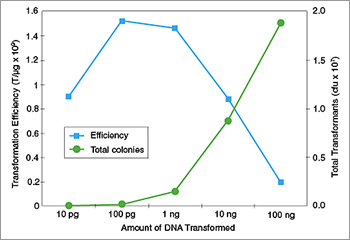
DNA Effects on Transformation Efficiency and Colony Output: The optimal amount of DNA to use in a transformation reaction is lower than commonly recognized. Using clean, supercoiled pUC19, the efficiency of transformation is highest in the 100 pg-1 ng range. However, the total colonies which can be obtained from a single transformation reaction increase up to about 100 ng.
Incubation of DNA with Cells on Ice
Incubate on ice for 30 minutes. Expect a 2-fold loss in TE for every 10 minutes you shorten this step.
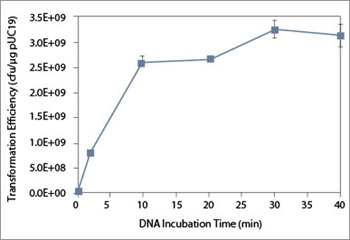
Effect of DNA incubation time on NEB 5-alpha competent E.coli transformation efficiency: 50 μl of competent cells were transformed with 100 pg of pUC19 control DNA following the provided High Efficiency Transformation Protocol except DNA incubation time varied from 0 to 40 minutes.
Heat Shock
Both temperature and time are specific to the transformation volume and vessel. Typically, 30 seconds at 42°C is recommended, except when using BL21 (NEB #C2530) which requires exactly 10 seconds.
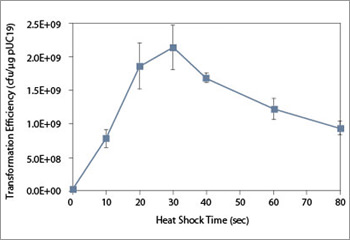
Effect of heat shock time on NEB 5-alpha competent E.coli transformation efficiency: 50 μl of competent cells were transformed with 100 pg of pUC19 control DNA following the provided High Efficiency Transformation Protocol except heat shock time varied from 0 to 80 seconds.
Outgrowth
- Outgrowth at 37°C for 1 hour is best for cell recovery and for expression of antibiotic resistance.
Expect a 2-fold loss in TE for every 15 minutes you shorten this step. - SOC gives 2-fold higher TE than LB medium.
- Incubation with shaking or rotating the tube gives 2-fold higher TE.
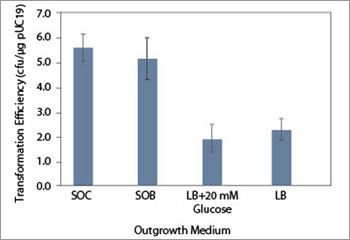
Effect of outgrowth medium on transformation efficiency: 50 μl of NEB 5-alpha competent E.coli was transformed with 100 pg of pUC19 control DNA following the provided High Efficiency Transformation Protocol with the exception of varying the outgrowth medium. NEB SOC outgrowth medium delivers the highest transformation efficiency.
Plating
- Selection plates can be used warm or cold, wet or dry with no significant effects on TE.
- Warm, dry plates are easier to spread and allow for the most rapid colony formation.
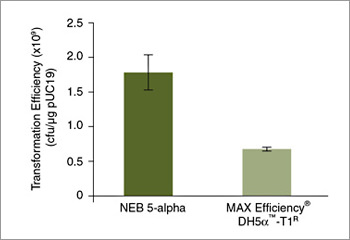
Benefit from the high transformation efficiencies of NEB 5-alpha: The transformation efficiencies of NEB 5-alpha and DH5α were compared using each manufacturer’s recommended protocols. Values shown are the average of triplicate experiments.
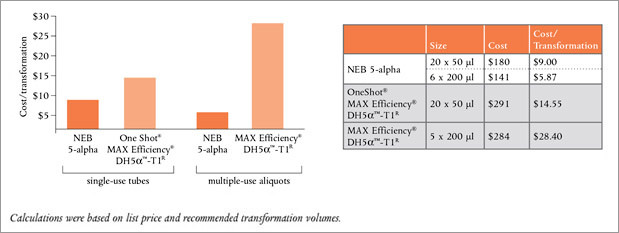
Take advantage of the low cost per transformation with NEB 5-alpha. Calculations were based on list price and recommended transformation volumes.
Further information can be found in our Technical Resources section or at neb.com


